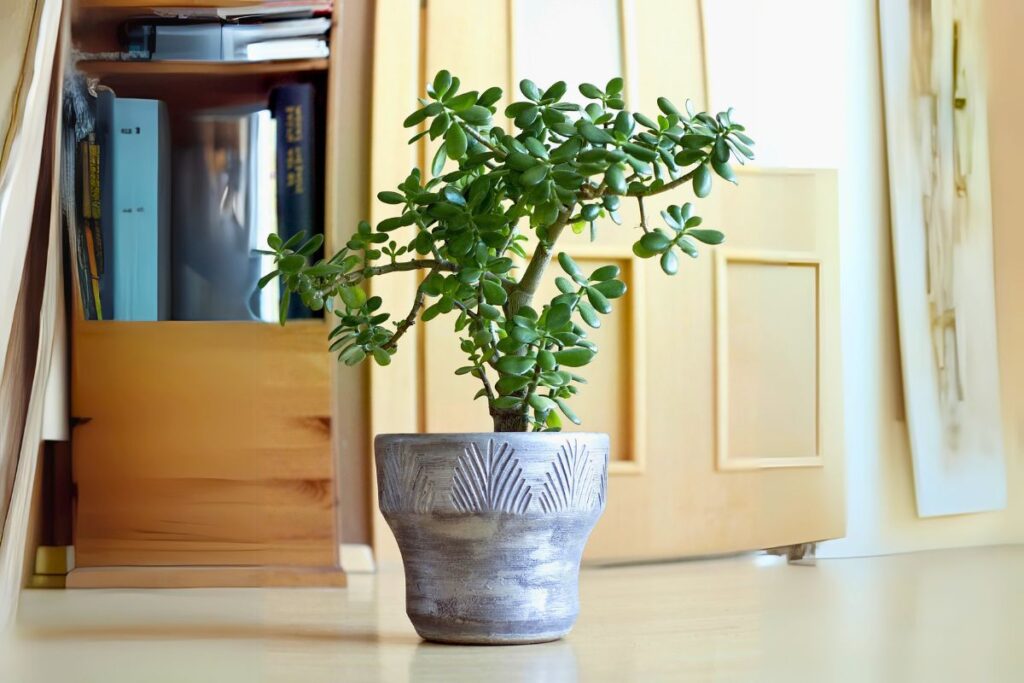Jade plants, known for their thick, glossy leaves and tree-like appearance, are a beloved choice for indoor gardeners. These resilient succulents are not only visually appealing but also easy to care for, making them perfect for both beginners and experienced plant enthusiasts. This comprehensive guide will provide you with everything you need to know about indoor care for jade plants, ensuring they remain healthy and vibrant all year round.

Contents
Understanding Jade Plants
Jade plants (Crassula ovata), also known as money plants or lucky plants, are native to South Africa and Mozambique. They are part of the Crassulaceae family and are prized for their fleshy, oval-shaped leaves and sturdy, woody stems. Jade plants can grow up to 3-6 feet tall indoors, making them a striking addition to any indoor garden.
Light Requirements
Jade plants thrive in bright, indirect light. They can tolerate direct sunlight, especially in the morning or late afternoon, but too much direct sunlight can cause their leaves to develop sunburn. Place your jade plant near a south or west-facing window where it can receive plenty of bright light. If natural light is insufficient, you can supplement with artificial grow lights to ensure your plant gets the necessary light.
Watering Routine
Proper watering is crucial for the health of jade plants. These succulents store water in their leaves and stems, so they prefer to dry out between waterings. Use a well-draining soil mix and a pot with drainage holes to prevent water from sitting at the bottom. Water your jade plant thoroughly when the top 1-2 inches of soil are dry. During the winter months, reduce watering as the plant’s growth slows down. Overwatering can lead to root rot, which is a common issue with jade plants.
Humidity and Temperature
Jade plants thrive in environments with low to moderate humidity, similar to their native habitats. They can tolerate a wide range of humidity levels, so there’s no need to worry about maintaining high humidity.
When it comes to temperature, jade plants prefer a warm environment. They thrive in temperatures between 65-75°F (18-24°C) during the day and slightly cooler temperatures at night. Avoid placing your jade plant near drafts, air conditioners, or heaters, as sudden temperature changes can stress the plant.
Soil and Fertilization
Jade plants prefer a well-draining soil mix. A combination of cactus or succulent mix and perlite works well. This mix ensures good aeration and prevents the soil from becoming waterlogged. It’s also a good idea to repot your jade plant every 2-3 years to refresh the soil and provide more space for root growth.
Fertilize your jade plant during the growing season (spring and summer) with a balanced liquid fertilizer diluted to half strength. Fertilize once a month to promote healthy growth. Avoid fertilizing during the fall and winter months when the plant’s growth slows down.
Pruning and Training
Pruning your jade plant helps maintain its shape and encourages bushier growth. Remove any dead or yellowing leaves and trim back leggy branches to promote new growth. Jade plants can be trained to grow in a desired shape by gently bending and tying branches. Regularly inspect your plant for pests such as mealybugs and scale, which can damage the leaves and stems.
Propagation
Jade plants are relatively easy to propagate from stem or leaf cuttings. Follow these steps to propagate your jade plant:
- Select a healthy stem or leaf from the plant and cut it with a clean, sharp pair of scissors or pruning shears.
- Allow the cut end to callus over for a few days to prevent rot.
- Insert the callused end into a small pot filled with a well-draining soil mix.
- Water the soil lightly and place the pot in a warm, bright location with indirect light.
- Keep the soil lightly moist until roots develop, which can take a few weeks.
Once the new roots are established, you can care for the cutting as you would a mature jade plant.
Common Problems and Solutions
Yellow Leaves
Yellow leaves can be a sign of overwatering or underwatering. Check the soil moisture and adjust your watering routine accordingly. If the problem persists, consider fertilizing your jade plant to provide the necessary nutrients.
Leaf Drop
Leaf drop can occur due to sudden changes in light, temperature, or humidity. Ensure your jade plant is in a stable environment with consistent conditions. Avoid moving the plant frequently and provide adequate light and humidity.
Pests
Common pests that affect jade plants include mealybugs, scale, and spider mites. Regularly inspect your plant and treat any infestations with insecticidal soap or neem oil. Isolate affected plants to prevent the pests from spreading to other houseplants.
Conclusion
Jade plants are a timeless and resilient addition to any indoor garden, offering thick, glossy leaves and a tree-like appearance. By providing the right light, water, humidity, and care, you can ensure your jade plant thrives and remains healthy. With a bit of attention and patience, you’ll be rewarded with a stunning and vibrant plant that will bring a touch of elegance to your home.
